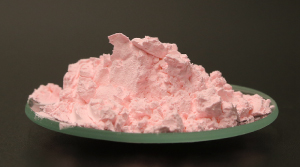Erbium oxide (Er2O3) is the compound in the oxide form of the rare earth metal erbium. Erbium oxide is also known as erbia and erbium trioxide. Erbium oxide has a pink color. The cubic crystal structure is the structure that erbium oxide has. However, under certain conditions erbium oxide could have a hexagonal structure. Erbium oxide is not soluble in water, with a high melting point at temperature of 2344oC. Hence, this erbium oxide compound is said to be well heat endurable and chemically durable under high temperatures. Erbium oxide films have a high dielectric constant. At room temperature erbium oxide is strongly photo luminescent compound. Erbium oxide has been used in variety of applications like microelectronic, optoelectronic, thermophotovoltaic and biomedical applications. Erbium oxide is even used in nuclear reactors.

Erbium oxide is used as colorant for glasses
Erbium oxide is used as burnable poison for nuclear fuel
Erbium oxide is used in the protection of and anticorrosion coating of steels
Erbium oxide is used in the fabrication of high-gain optical waveguide amplifiers and optoelectronic integrated circuits
Erbium oxide is used for gate dielectrics of silicon-based microelectronic devices due to its high dielectric constant
Erbium oxide is used in solar cells as anti-reflection coating
Erbium oxide is used as insulating coating since it is effective in reducing magneto hydrodynamic pressure
Comments
Post a Comment